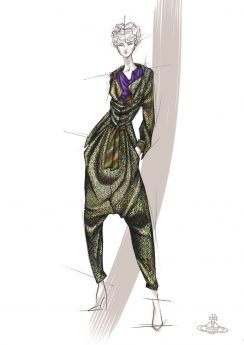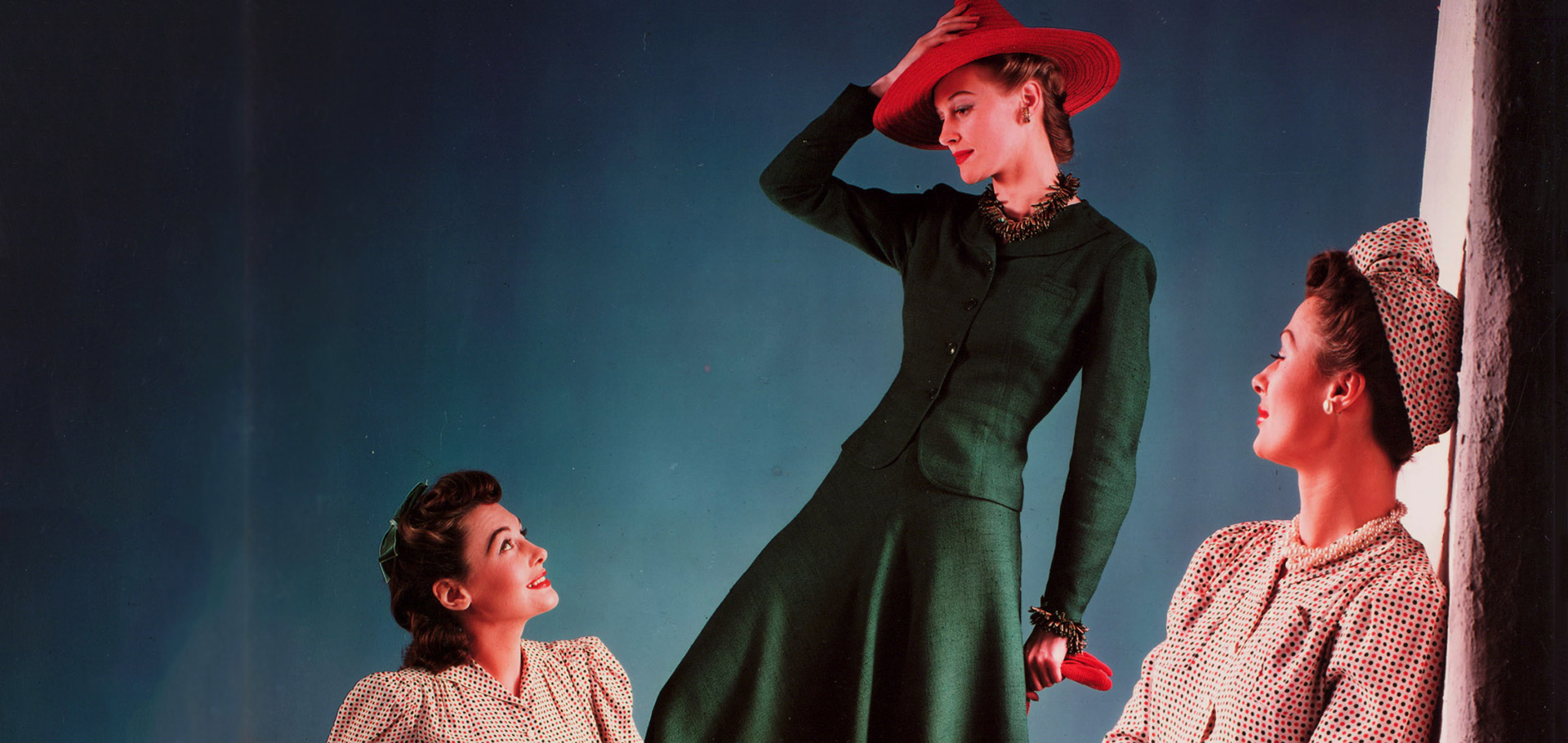Fight for freedom
Women went into the workforce in large numbers during the two world wars but were then encouraged back into domesticity. How did the clothing they wore reflect these social changes, ask two new exhibitions. By Antonia Charlesworth
In the middle of the commemorations of the First World War centenary there is no shortage of arts and cultural events celebrating the lives of the 750,000 British men who lost their lives in one of the deadliest conflicts in human history. Celebrated less are the women who stayed on the home front who kept the country ticking over – and Britain’s military efforts strong – by moving into the workforce while continuing to carry out domestic duties and childcare.
Before 1914 the women’s movement had reached its most extreme – employing military tactics, mimicked from Russian exiles, such as arson – leading to their imprisonment and gruelling hunger strikes. But a more mainstream faction under Emmeline and Christabel Pankhurst saw war as an opportunity for women to prove their capabilities and by its end, in 1918, they had turned public opinion in their favour and were granted the right to vote.
“As horrific and dreadful as the war was it was a really positive time for women,” says Darrell Vydelingum, creative director of Fashion and Freedom – a new exhibition at Manchester Art Gallery that shows how the freedoms that war afforded women were reflected in changes in women’s dress. “Women’s attitudes changed, then society, the government, the media followed.”
By 1918 one million women worked in munitions, their children in 100 new nurseries part funded by government. The number of women working in transport rose sharply to 50,000, the Women’s Army Auxiliary Corps allowed 100,000 women to join the armed forces and the Women Patrols – the first female police officers – emerged.
“They couldn’t have women loafing around in slacks and long baggy sweaters.”
“There’s a great story about the women who started in the London Metropolitan Police,” says Vydelingum, “They didn’t have uniforms but one of them had an account at Harrods, so the first suit for a female police officer was made there, but it wasn’t female tailoring.”
The necessity for women to wear practical clothing resulted in its becoming fashionable and, shortly after the war, the first female suit for fashion’s sake was created by Coco Chanel. But it wasn’t just female tailoring that wartime fashion gave rise to – waistlines loosened and hemlines and hair length shortened. The shifts in fashion are interpreted by designers including Vivienne Westwood, Sadie Williams, Holly Fulton and
Roksanda in Fashion and Freedom.

“Before the First World War women’s position in society was reflected in what they were wearing – very tight, restrictive, boned corsets, heavy Edwardian clothing which they could barely breathe in, let alone move or work in.”
At the end of the war many women were stripped of their new-found freedoms – munitions jobs were lost and transport jobs were closed to women. But 9 per cent of men under 45 died in the war and many women found themselves heading households. Professions such as teaching and medicine were opened up to women who chose to remain single so, for some, singledom was preferable. Despite anxiety about falling birth rates, and an effort to get women back into the home, post-war family sizes shrunk.
“When men came back women were expected to go back into their homes but the genie’s bottle was already opened and it was too late then,” says Vydelingum.
He’s worked in fashion for over a decade but Vydelingum admits he was unaware of how much modern style owes to the First World War before he was asked to create the exhibition.
“From trouser suits to shorter hemlines and jumpsuits, which are really fashionable at the moment, that was the starting point. The 1920s is seen as a really important time in fashion because of the softer silhouette, the Jazz Era and women having more attitude but it is all because of the First World War.”
But if fashion during the First World War represents the agitation among women to earn autonomy then Second World War fashion offers a stark contrast. From using beetroot juice to add a splash of lip colour, to tea staining legs and drawing on stocking seams with kohl, another Manchester exhibition, Fashion on the Ration at the Imperial War Museum North, shows how women maintained beauty standards under strict austerity in 1940s Britain.
“A quote from the editor of British Vogue at the time stated ‘It will be frightful if the war turns us into a nation of slothens,’” explains Julie Summers, whose eponymous book was the starting point for the IWM exhibition.
“The understanding was that women had a duty to look great for two reasons – one was to cock a snook at Herr Hitler and to make the Germans absolutely aware that the British were not for buckling, and the second was that they wanted women to look beautiful to give the men, who were going off to fight, morale. It’s terribly sexist but I’m afraid it’s what it was like in the 1940s – they couldn’t have women loafing around in slacks and long baggy sweaters because that would be demoralising for the poor soldiers and airmen.”
What had happened in the 21 years between the world wars that found women stripped of their newfound freedom and embracing the femininity that had all but disappeared?
“The focus in the 1920s was on the generation of the lost youth, women wanted to look like little boys basically – not quite as crude as that – but by the 1930s the influence from Paris was huge,” says Summers. The waist was reintroduced and the bra was designed, splitting the bust for the first time, giving the female figure more shape. “The critics of the late 1940s decried the hideous styles of the 1920s – the last post-war era.”
This was exacerbated by the mass production of clothes by the government from 1942 onwards. “The utility designs were by the top couturiers of the 1930s – Edward Molyneux and Digby Morton and so on and it meant that women on a low income could buy a dress designed by a man who would normally design for the Queen or for aristocracy – for 30 shillings rather than 30 guineas,” says Summers.
“The progress women made in the First World War came through in the next 20 years and the focus for women was education. There were fewer battles to fight but they didn’t run as fast as they could have done into feminism – which could have hit by the 1940s – because they were being held back by men.”
“It was very difficult for that woman, who could change a piston on an engine, to have to go and cook lumpy custard, boil tiny potatoes and look after babies.”
Although the First World War introduced trousers for women, by 1940 only 11 per cent of people in the countryside and 40 per cent in London thought it acceptable for women to wear them. The Second World War did change this, again because of practicality as women moved back into the workforce in large numbers. But Summers points out that after the Second World War there was a far bigger push back into the home for women, with the government employing policy to actively make women responsible for rebuilding the country and rebuilding family life, characterised by the post-war baby boom.
“While in many ways they’d had more freedom than the First World War girls they hadn’t recognised it because they hadn’t come from such a terrible starting place,” says Summers.
The ongoing insistence on the significance of motherhood and domesticity is characterised by the symbol of the 1950s housewife, and her dissatisfaction bubbling under the surface. In 1963 Betty Friedan kicked off second wave feminism with The Feminine Mystique, in which she identified “the problem with no name” – the depression and hopelessness that many women felt.
“Loads of women found it very hard to go back to the hearth and divorce sextupled after the Second World War,” says Summers. “It was very difficult for that woman, who could change a piston on an engine, to have to go and cook lumpy custard, boil tiny potatoes and look after babies.”
There is no doubt that fashion today is influenced by both wartime and post-war fashions. Gatsby fever has given rise to the straight, androgynous lines of the 1920s and bobbed hair styles, while austerity has inspired a return to the make do and mend attitude of the Second World War and vintage style – headscarves, victory rolls and 1940s-inspired tea dresses. But is fashion ultimately liberating or constraining?
“Certainly in the war it was both,” says Summers. “One thing it did do was take away the stigma of being poor. It was no longer a humiliation or an admission of defeat to have secondhand clothes for your baby or a patch on a pair of trousers.”
Vydelingum agrees you can’t make a hard and fast rule. “There are still issues around what women wear and how men want women to dress, there still need to be a hell of a lot of changes, but many women don’t give a damn and wear what they want.”
Fashion and Freedom is at Manchester Art Gallery until 27 Nov. Fashion on the Ration is at the Imperial War Museum North, Manchester, until May 2017. Fashion on the Ration by Julie Summers is available at iwmshop.org.uk (£8.99)

Leave a reply
Your email address will not be published.